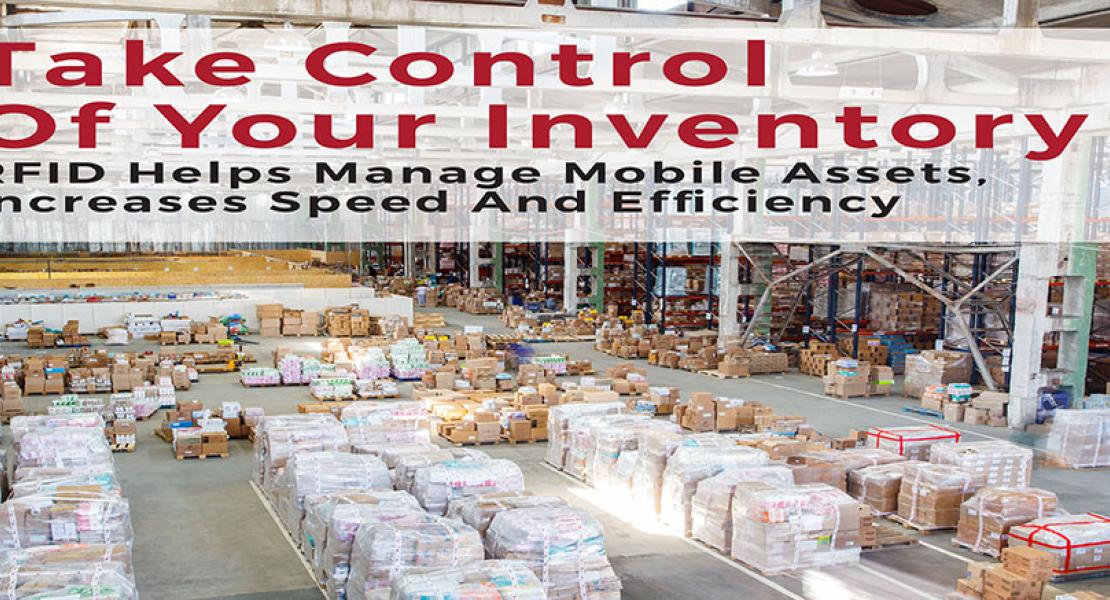Imagine walking into a room with an RFID reader and just pressing a button to complete a physical inventory that used to take hours or even days to complete. Or perhaps you need to inventory a recent inbound shipment of items. Completing the entire task takes less than a minute by running the entire pallet through a portal reader instead of individually scan each item on the pallet. These are just two examples of the efficiencies gained when using RFID tags in an inventory management process.
Radio frequency identification can be a very effective tool when used to help manage inventory. Whether it’s a company’s fixed assets, i.e. equipment and machinery, or other inventory assets a company uses to make the products they ultimately sell; there are many advantages to using RFID technology for inventory management.
RFID Increases Speed, Efficiency When Taking Inventory
Two major advantages of using RFID to manage inventory are speed and efficiency. RFID uses radio frequency waves to identify an object and does not require line-of-sight to transmit data – meaning the user does not need to see the tag to read the tag. In addition, many RFID tags can be read simultaneously and without regard to orientation rather than one at a time. Think of an entire pallet of goods going through a portal reader versus needing to be individually scanned either manually or with a fixed reader that needs the items oriented a specific way. Because of this, RFID is an inherently faster and more efficient way to manage inventory.
RFID Provides Greater Visibility Across Supply Chain
In addition to speed and efficiency, RFID provides greater visibility across the supply chain to an organization when used in an inventory management system. Users know almost immediately what they have on hand for materials and what needs to be ordered thanks to real-time updates.
The cost of labor in any inventory management system is going to be the most expensive component and using RFID for inventory management to automate certain processes, i.e. checking inventory counts, helps reduce overall labor expenses.
Another advantage of using RFID for inventory management is the amount of storage available in an RFID tag. Compared to a traditional barcode tag, an RFID tag can hold much more data about the particular asset it is applied to. However, we often caution against storing everything about a specific asset in the RFID tag. Just because you can, doesn’t necessarily mean you should. Using a license plate approach with RFID tags allows for more flexibility on the back end to make changes without needing to retag.
Utilizing RFID for inventory management also helps companies optimize use of their fixed assets. Whether it’s tracking maintenance information about production equipment in order to ensure it is available and functioning when needed or the ability to track mobile assets as part of an inventory management system, using RFID in inventory management provides a way to track either the item itself or information about the item.
A prime example of the benefits of RFID in an inventory management application is with mobile assets, i.e. returnable containers or pallets which, when lost or misplaced, can cost companies thousands if not millions of dollars in capital investment. In addition, companies spend thousands more in lost manhours looking for missing assets. Using RFID for inventory management with both their fixed and mobile assets helps companies optimize inventory and reduce loss or theft; thereby reducing expenses.
RFID installation costs can be substantial
A primary disadvantage of using RFID for inventory management is the cost of implementation. Depending on the application, the infrastructure needed for an RFID installation can be substantial, so it is important that users complete an ROI analysis prior to initiating the project. In addition, RFID systems can be cost prohibitive when scaling so that is important to consider when developing the objectives for the system.
Another potential disadvantage of utilizing RFID for inventory management is the possibility of RF interference in the warehouse or facility where the inventory needs to take place. However, this can be mitigated through proper planning and testing when designing the RFID installation.
In summary, using RFID in inventory management is something that should be carefully evaluated when looking to improve overall visibility and efficiency in an organization’s overall system.
If you're interested in taking control of your inventory with RFID, contact us today at [email protected].
 | About the Author: Marianne AlvaradoMarianne Alvarado is our Vice President of Sales. Alvarado joined Metalcraft in March of 2000 as a Territory Specialist, became Sales Manager in January 2022 and was named Vice President of Sales during August of 2023. She leads both the Outside and Inside Sales teams. Marianne lives in Davenport with her husband, Dave Beeman. Mobile Phone: 641-529-9492 Email: [email protected] Office: 3360 9th St. SW, Mason City, IA 50401 Office Phone: 641-423-9460 |




